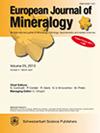Detrital garnet petrology challenges Paleoproterozoic ultrahigh-pressure metamorphism in western Greenland
IF 1.7
3区 地球科学
Q2 MINERALOGY
引用次数: 0
Abstract
Abstract. Modern-style plate tectonics is characterised by the global operation of cold and deep subduction involving blueschist facies and ultrahigh-pressure metamorphism. This has been a common process since the Neoproterozoic, but a couple of studies indicate similar processes were active in the Paleoproterozoic, at least on the local scale. Particularly conspicuous are extreme ultrahigh-pressure conditions of ∼ 7 GPa at thermal gradients < 150 ∘C GPa−1 proposed for metamorphic rocks of the Nordre Strømfjord shear zone in the western part of the Paleoproterozoic Nagssugtoqidian Orogen of Greenland. By acquiring a large dataset of heavy minerals (n = 52 130) and garnet major-element composition integrated with mineral inclusion analysis (n=2669) from modern sands representing fresh and naturally mixed erosional material from the metamorphic rocks, we here intensely screened the area for potential occurrences of ultrahigh-pressure rocks and put constraints on the metamorphic evolution. Apart from the absence of any indications pointing to ultrahigh-pressure and low-temperature–high-pressure metamorphism, the results are well in accordance with a common Paleoproterozoic subduction–collision metamorphic evolution along a Barrovian-type intermediate temperature and pressure gradient with a pressure peak at the amphibolite–granulite–eclogite-facies transition and a temperature peak at medium- to high-pressure granulite-facies conditions. In addition, we discuss that all “evidence” for ultrahigh-pressure metamorphism proposed in the literature for rocks of this area is equivocal. Accordingly, the Nordre Strømfjord shear zone is not an example of modern-style plate tectonics in the Paleoproterozoic or of very low thermal gradients and extreme pressure conditions in general.碎屑石榴石岩石学挑战了格陵兰西部古元古代超高压变质作用
摘要现代板块构造的特征是全球性的冷深俯冲作用,涉及蓝片岩相和超高压变质作用。自新元古代以来,这是一个常见的过程,但一些研究表明,类似的过程在古元古代也很活跃,至少在局部范围内是这样。特别明显的是温度梯度< 150°C GPa−1的~ 7 GPa的极端超高压条件,这是格陵兰岛纳格苏托奇甸造山带西部古元古代的Nordre Strømfjord剪切带形成的变质岩。通过获取大量重矿物(n= 52 130)和石榴石主元素组成数据集,并结合矿物包裹体分析(n=2669),从代表变质岩新鲜和自然混合侵蚀物质的现代砂岩中,我们在这里严格筛选了该地区超高压岩石的潜在产状,并对变质演化进行了限制。除了没有任何指向超高压和低温-高压变质作用的迹象外,结果很好地符合古元古代-俯冲-碰撞变质演化,沿巴罗维亚型中温压力梯度,压力峰值出现在角闪岩-麻粒岩-榴辉岩相过渡时期,温度峰值出现在中高压麻粒岩相条件。此外,我们还讨论了文献中关于该地区岩石超高压变质作用的所有“证据”都是模棱两可的。因此,nordre Strømfjord剪切带并不是古元古代现代型板块构造的典型,也不是一般的低热梯度和极端压力条件的典型。
本文章由计算机程序翻译,如有差异,请以英文原文为准。
求助全文
约1分钟内获得全文
求助全文
来源期刊
CiteScore
2.80
自引率
9.50%
发文量
40
审稿时长
6-12 weeks
期刊介绍:
EJM was founded to reach a large audience on an international scale and also for achieving closer cooperation of European countries in the publication of scientific results. The founding societies have set themselves the task of publishing a journal of the highest standard open to all scientists performing mineralogical research in the widest sense of the term, all over the world. Contributions will therefore be published primarily in English.
EJM publishes original papers, review articles and letters dealing with the mineralogical sciences s.l., primarily mineralogy, petrology, geochemistry, crystallography and ore deposits, but also biomineralogy, environmental, applied and technical mineralogy. Nevertheless, papers in any related field, including cultural heritage, will be considered.

 求助内容:
求助内容: 应助结果提醒方式:
应助结果提醒方式:


